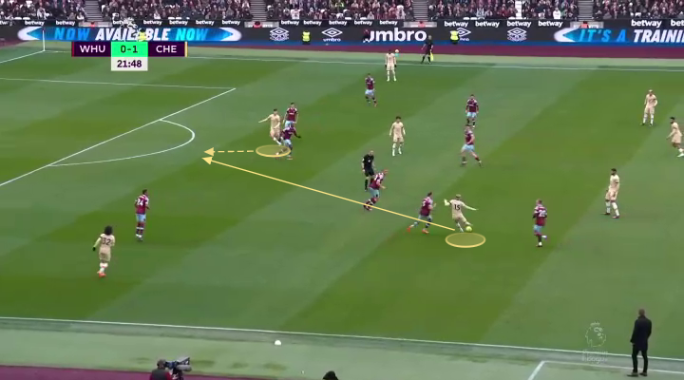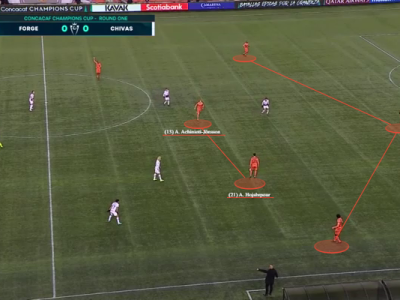
In creating a thorough report for a pro club, your inclination might be to include all the information you can possibly find. I often thought the same way, writing 4,000 word articles detailing insights into every player. But contrary to popular belief, you don’t need to detail everything there is to know about a particular team when writing a report. It’s important to distill the most relevant information for the team, taking into account their own style and principles of play.
The most ‘comprehensive’ of opposition reports are supposedly meant to disclose how the opposite team plays in each distinct phase of the game – from defense to attack to transitions to set-pieces. But chances are, the coaching staff already have a great deal of knowledge to the vast majority of these characteristics. It’s a nice, sequential way of breaking down the report to distill the various information between each third of play. But it’s perhaps only creating room for an information overload.
Instead, when conducting opposition reports for pro clubs, I try to keep the slide-deck to the most pertinent information possible. Ultimately, what does football come down to on the most basic level?
Scoring goals, and stopping the opposition from scoring.

It’s an over-simplification that does nothing to detail the actual mechanisms for the how, when and where to winning football matches, but this is the most fundamental aspect that we want to present in any team report. How can they keep the ball or win it back efficiently enough so that they can find mechanisms for scoring goals? Conversely, how can they do the same (keep the ball, win it back), while also eliminating space and time in the quest to stop the opposition from scoring goals.
Anything that is not guided to that quest feels slightly out of place, and anything included in the report should always have that context in mind. In other words, the ‘why’ to everything you detail in your report should be about either finding ways to keep the ball and score goals; or about stopping the opposition from doing the same.

I therefore focus on the opposition’s key strengths in attack, the deeper, undercover mechanisms for how they build play all the way into the final third, and how they tend to score goals from those connections. I also form insights into the opposition’s key weaknesses in defense, and how those weaknesses could be vulnerable for further exploitation. Notice the difference. I don’t necessarily need to waste time revealing everything they do extraordinarily well in defense, or everything they fail to accomplish in attack.

That information could be valuable! It might help the team to understand where the opposition will likely excel on the defensive end, so they can avoid those situations. It might even help the team understand where the opposition will falter in attack, so they can illuminate more of those moments. But most of the time, the opposition won’t score from sucking. In the conversation of time, where the opposition succeed in defense is also not particularly helpful to the team’s quest to score goals against them. Again, it’s not as though these insights need to be eliminated from an opposition report.
But here’s the difference: Unless the fact that they have a hulking 6’6 centre-half who wins everything in the air is imperative to their overall style of play, I might rather know that the same 6’6 centre-half frequently jumps up from his line to make challenges, thus vacating space in behind. I could casually mention how dominant he is in the air, but my aim is to help the team understand how even in spite of that, they can still win the day. You don’t want to discourage the team you’re writing for, instead providing actionable solutions as to how they can hurt the opposition.

When it comes to the communication aspects, it’s much of the same to what I wrote in The simple vs. complex language debate in football tactics writing & analysis. The language is kept relatively simple, while dropping occasional glimpses of ‘complex terminology’ that all football coaches and clubs will understand. The writing is short, succinct and condensed to a greater degree than if I were writing an article for a larger audience on the topic. When presenting to clubs, I tend to avoid the humour or obscure interjections of word-play that may pop up in one of my articles. I also tend to avoid phrases like obscure interjections, and use the simpler versions of those words to save on time and create a universal understanding.

I include live captures from matches, diagrams, and even occasional glimpses of video throughout every page of the report, always helping to bring context to the descriptions. And again, everything is framed around how the team can actually use the insights on the pitch, and suggestions for potential solutions to what I’m spewing out. I don’t just say that the opposition like to play passes into a certain area of the pitch, but I provide potential guidance as to how they can either stop that from happening, or combat those passes once they’ve occurred.

After providing the most relevant information, I also provide a quick summary at the end, reminding the club of what they need to consider in their quest to stop the opposition from scoring, and what they need to consider when finding pathways to scoring success themselves.
The writing of these reports and the knowledge accumulation toward that information only comes from hours of video footage extrapolation, and a detailed understanding of the team in question from watching several full-length matches. You cannot understand the wider scope of a team’s tactics without watching how play evolves from one moment to the next in any other way like you can by watching the full match. So it’s important to not rely on shorter video clips or curated playlists, and to instead use those video clips and curated playlists as supplementary value to your pre-existing understanding of a team.

I take notes as I move along, with the categories usually along the lines of ‘Strengths in Attack’ and ‘Weaknesses in Defense’, helping to frame my report as I watch the footage and create images. That way when it comes to presenting the most relevant information, you’ve already done the critical thinking and brainpower required. In remembering all of your insights, it’s also useful to complete your video analysis and written report all within a relatively short time period.

Taking notes will help to keep that information fresh, but you also don’t want to rely on your notes to help you remember what you thought days prior. The fast-paced nature of opposition reports at the pro level probably helps this to become less of an issue, but it’s still important to set yourself up for success.
So when writing opposition reports for pro clubs, remember to keep the information succinct, and to the most critical points of football – scoring goals, and stopping the opposition from doing the same. In the quest to create those insights, you may find value in focusing on the strengths of the team in attack, and their weaknesses in defense. How you structure your report can be guided toward the team’s desires or your own. But without the inclusion of the relevant information, both you and the team will struggle to reap the rewards.
So there it is! How to write opposition reports for pro clubs! If you want to gain more insight into how to write performance-based analyses, check out my Consultation, and our Introduction to Football Analysis Course. Thanks for reading and see you soon!
YOU MIGHT ALSO ENJOY
Chaos vs. Control: A Collision of Principles
Some like to approach games in a disciplined structure, intentionally and meticulously dictating games to their own tempo. Others opt for a more emotionally-charged philosophy, reliant on the belief, energy and willpower of their trusted eleven on the field.
Game of Numbers #37 – Forge FC’s use of centre-backs in midfield like Manchester City
For the unfamiliar, Forge FC are the Manchester City of the Canadian Premier League. They play a possession-based 4-3-3, stacked with ball-savvy savants, and a culture that embodies winning. The Canadian Premier League’s been around since 2019 now. Forge have won the Playoffs in four of the five seasons, and lost the final in the…
Why centre-backs are becoming fullbacks: The tactical trend that defined 2023
It might be wrong to credit this tactical approach to Pep Guardiola. After all, the origin story to the ‘fullback’ is because the defender was fully back. However, in operating with a centre-back that steps up into midfield, Guardiola also created a construction within his team that regularly positioned centre-backs out wide. From then on,…





One thought on “Conducting opposition reports for pro clubs”